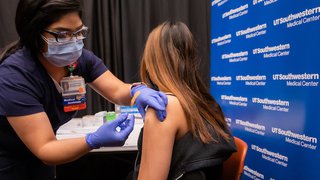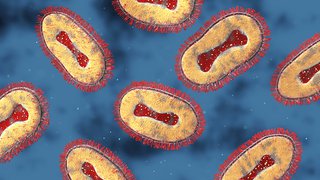COVID-19 vaccines: Separating myths from reality
January 28, 2021

A year after the first case of COVID-19 was confirmed in the United States, two safe and highly effective vaccines are being distributed across the country. Several other vaccines are close to seeking emergency authorization from the FDA. And millions of health care workers and people in high-risk groups have already been vaccinated.
In a survey conducted Dec. 17-20, 2020, nearly 70% of Americans said they would most likely get vaccinated, which marks a significant increase from 59% just a month earlier.
Yet there remains a strong undercurrent of resistance and disinformation about the vaccines. Concerns range from side effects and the speed at which the vaccines were developed to more nefarious and false allegations about the vaccines altering your DNA or containing a microchip tracking device.
The truth is vaccines represent our best chance of ending this public health emergency. Now is the time to arm ourselves with the facts – and separate myths from reality.
MYTH: The COVID-19 vaccines can give you the virus.
REALITY: Neither vaccine contains live virus, so there’s no risk of it causing disease.
The Pfizer-BioNTech and Moderna vaccines that have been authorized by the FDA for emergency use both employ a technology called messenger RNA (mRNA), which carries the genetic code used to make the SARS-CoV-2 spike protein and provoke an immune response. Some vaccines use a weakened or inactive version of a virus to create an immune response; these vaccines do not.
MYTH: The mRNA vaccines are new and not very effective.
REALITY: Both vaccines offered nearly 95% efficacy in clinical trials.

The Phase 3 clinical trials involved thousands of people. Pfizer’s vaccine was 95% effective; Moderna’s was 94.5%. That’s about as good as it gets, said Trish Perl, M.D., Chief of UT Southwestern’s Infectious Diseases Division. By comparison, vaccines for chickenpox are 92% effective, measles-mumps-rubella 97%, and polio 99%.
Yes, the COVID-19 vaccines are the first mRNA vaccines authorized by the FDA, but mRNA technology has been used successfully for decades in treatments for other diseases such as cancer and cystic fibrosis.
| Vaccine | Pfizer/BioNTech | Moderna |
|---|---|---|
| Technology | mRNA | mRNA |
| Phase 3 trial participants | 44,000 | 30,000 |
| Efficacy rate | 95% | 94.5% |
| Doses needed | 2, 21 days apart | 2, 28 days apart |
| Status | Authorized by FDA | Authorized by FDA |
| Storage temperature | -94 degrees Fahrenheit | -4 degrees Fahrenheit |
MYTH: Vaccines using mRNA can alter your DNA.
REALITY: The mRNA never enters the nucleus of your cells, where DNA lives, so it cannot affect your DNA.
The mRNA vaccines carry the genetic code for the spike protein, and they work by showing your immune system a key portion of the virus, so when your body encounters the virus in real life, it recognizes the invader and mounts an immune response to fight it. The mRNA is not in your body long; natural enzymes break it down quickly.
MYTH: The vaccines won't protect us against new strains of the virus.
REALITY: New studies show the vaccines are effective against several variants.
The FDA said recently that scientists tested the vaccines against several emerging variants, including one detected in the U.K., Brazil, and South Africa, and the vaccines have proven effective so far against those mutations.
Scientists, including a team at UT Southwestern, are continuing to monitor for variants of the virus. In the lab, they are going through a process called genomic sequencing, which can help measure how contagious the variants are and whether the current vaccines will provide protection against them.
Both Pfizer and Moderna have said they could alter their vaccine formulas slightly, if necessary, to create additional protection against new emerging strains.
MYTH: Pharmaceutical companies skipped steps to produce the vaccines faster.
REALITY: The vaccines followed a well-established testing regimen.
Any new drug or vaccine must follow an arduous and specific clinical trial testing process before the FDA will even consider authorization. No steps were skipped for the COVID-19 vaccines. Research phases were performed concurrently, rather than consecutively, and wait times for review were substantially reduced through Operation Warp Speed, the federal program that invested in the vaccines to try to end the pandemic.
MYTH: Political factors influenced the vaccine authorization process.
REALITY: An independent board of experts reviewed the trial and testing data.
Career scientists – not politicians – at the FDA review the clinical trial data after receiving the recommendation from the independent monitoring board. And all of the clinical trial information will also be published in peer-reviewed journals, so the process is transparent and verifiable. In fact, UT Southwestern assembled its own team of experts to independently review the clinical trial data, and our panel deemed the vaccines safe and effective before offering them to our employees and patients.
MYTH: The vaccine can cause infertility.
REALITY: There is no evidence COVID-19 vaccines affect fertility.
False claims on the internet have suggested the SARS-CoV-2 spike protein resembles the protein crucial for formation of the placenta, and the vaccine might target them. But virologists say the proteins are not similar enough to confuse antibodies or cause infertility.
MYTH: You shouldn’t get the vaccine if you are pregnant or breastfeeding.
REALITY: Pregnant and breastfeeding patients should not be excluded from vaccinations, the CDC says.

Even though pregnant and breastfeeding women were not included in the first round of clinical trials, about two dozen participants in the Pfizer trial became pregnant during the studies; none reported complications from the vaccine. (Pregnant and breastfeeding patients have been added to the next phase of clinical trials.)
UT Southwestern recommends pregnant patients discuss vaccine options with their Ob/Gyn and consider their risks related to COVID-19 infection. The mRNA vaccines do not contain viral material, so the CDC says they do not pose a risk to breastmilk-fed infants.
RELATED READING: Pregnancy and COVID-19 vaccines.
MYTH: You don’t need to get two doses of the vaccine to get protection.
REALITY: To achieve full protection, you do.
The first shot triggers the immune response, and the second, often called a “booster,” primes the body to memorize the virus so it will recognize it immediately in the future and fight it off. Both vaccines provide some immunity 7-10 days after the first shot, but to achieve the 94%-95% immunity level you need the “booster.” (Full protection comes about two weeks after that second shot.) If you skip the second shot, you won’t develop full immunity – and you’ll be wasting a valuable dose of vaccine.
MYTH: The vaccines’ side effects are worse than getting COVID-19.
REALITY: More than 425,000 people have died from COVID-19 in the U.S. so far.
About 1%-2% of COVID-19 infections result in death. Another 10%-20% require hospitalization. Another 30% of COVID-19 patients have long-lasting symptoms. The vaccine is much safer, with only some people experiencing minor, short-term side effects that include arm soreness, fatigue, chills, fever, or headaches for a day or two.
Texas is using the Vaccine Adverse Event Reporting System (VAERS), a national system co-managed by the CDC and FDA, to track vaccine safety and side effects.
MYTH: You shouldn’t get the vaccine if you have allergies.
REALITY: Allergies to food, pets, the environment, or latex should NOT affect your ability to receive the vaccine.
Among the millions of vaccines already given, about 30 cases of severe allergic reactions, or anaphylaxis, have been reported. Those cases are believed to be related to allergies to polyethylene glycol (PEG), a chemical used in many medicines, including the vaccines. If you’ve had a severe allergic reaction to another vaccine or injectable therapy, consult your doctor before receiving a COVID-19 vaccine.
All patients should be asked to wait in an observation area for at least 15 minutes after they are vaccinated, where they will be monitored by a medical professional. If a patient experiences anaphylaxis, it can be quickly reversed with epinephrine and other medicines.
Vaccine reactions
As the first wave of people receive the COVID-19 vaccines, a few cases of anaphylactic reactions have created concerns among people with severe allergies. Dr. Rebecca Gruchalla, Chief of UT Southwestern’s Division of Allergy and Immunology, explains what might be causing these rare events, and advises how people with severe allergies should proceed.
MYTH: If you’ve had COVID-19, you don’t need to get vaccinated.
REALITY: The CDC recommends vaccination for people who have had COVID-19.
It’s unclear how long natural immunity lasts and there have also been a few reported cases of re-infection, so the CDC advises vaccination for people even after recovering from COVID-19.
MYTH: COVID-19 vaccines use fetal tissue.
REALITY: Neither of the COVID-19 vaccines used fetal cells in the research or manufacturing.
Fetal cells were not used in the development or production of either the Pfizer-BioNTech and Moderna vaccines. Some social media and internet posts have suggested that COVID-19 vaccines used human cell lines in their production, but the Pfizer and Moderna vaccines both were created using mRNA technology, which employs synthetic material made from a genetic code template in a lab.
MYTH: COVID-19 vaccines contain a microchip used to track people.
REALITY: There is no microchip or metal in the vaccines.
This conspiracy theory started after Microsoft founder Bill Gates suggested the vaccines use a digital certificate to make it easier to maintain records of how many people have been vaccinated. The technology he was referencing is not a microchip and it has not been implemented, but that hasn't stopped misinformation from spreading about Gates and his supposed intentions during the pandemic.
MYTH: Vaccines cause autism.
REALITY: No credible studies link vaccines and autism or autism spectrum disorder.
This myth, which was around well before the COVID-19 vaccines, was triggered by a study involving just 12 children. It was later retracted after the British medical journal that published it in 1998 said it had been deceived by the study’s lead author. Properly designed studies involving more than 1.2 million children have established that there is no link between childhood vaccines and autism, according to the CDC.
MYTH: The pandemic was planned to get people to take vaccines.
REALITY: This debunked theory was put forth in a video called Plandemic.
The 26-minute video, which circulated on social media and was viewed millions of times in a few days, featured a discredited scientist spreading a deliberate misinformation campaign. Each point in the video has been debunked and the video has been removed from social media platforms.
MYTH: If you get the vaccine, you don’t have to a wear a mask and social distance.
REALITY: Vaccination reduces risk but doesn’t eliminate it. Keep wearing a mask.

Until a majority of the population has been vaccinated, wearing a mask, washing your hands, practicing physical distancing, and avoiding large, indoor gatherings will continue to be important tools to limit spread, according to the CDC. Also, it’s still not clear if vaccinated people could develop asymptomatic infection and potentially spread the virus.
Experts have estimated that at least 70% of the population will need to be vaccinated to achieve herd immunity and life can return to normal.
For more information on the COVID-19 vaccines, including answers to frequently asked questions and how to schedule a vaccine appointment with UT Southwestern, please visit utswmed.org/vaccines.














